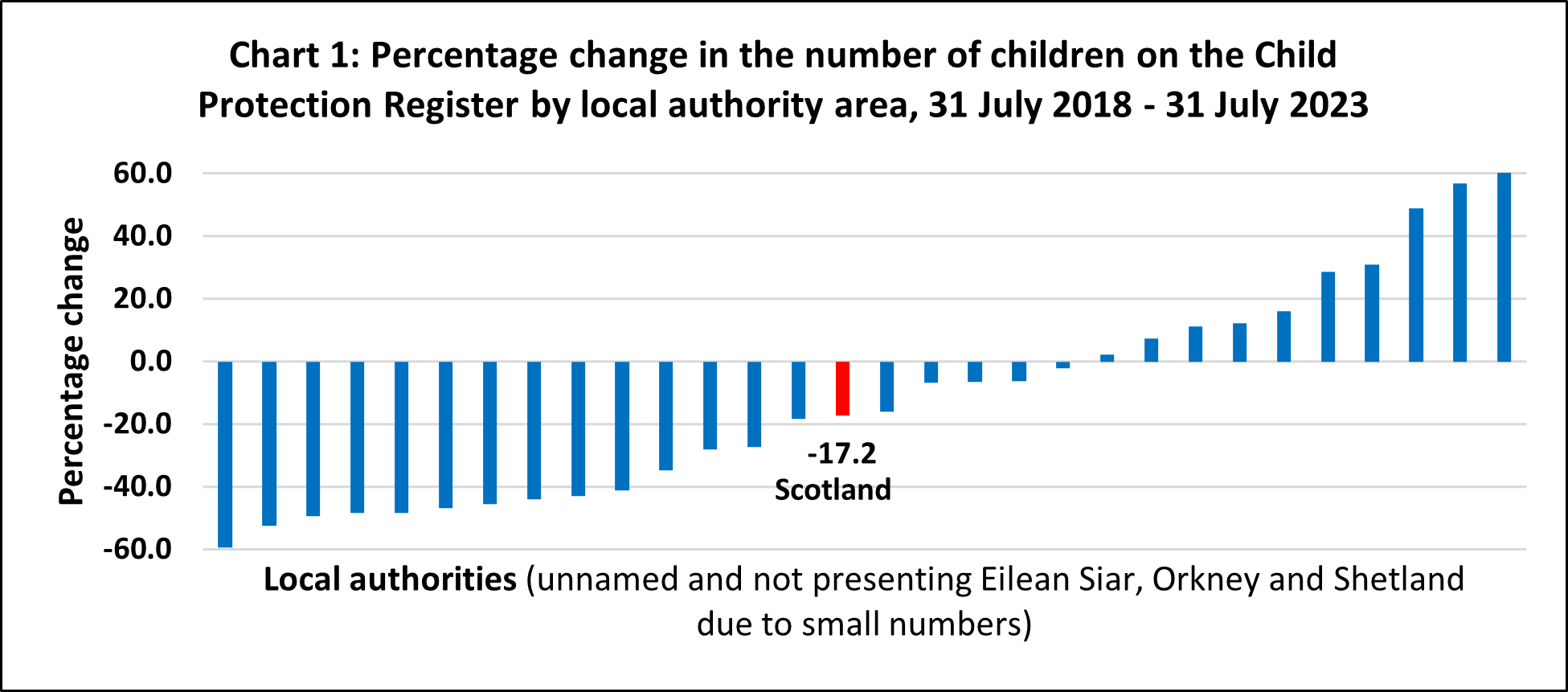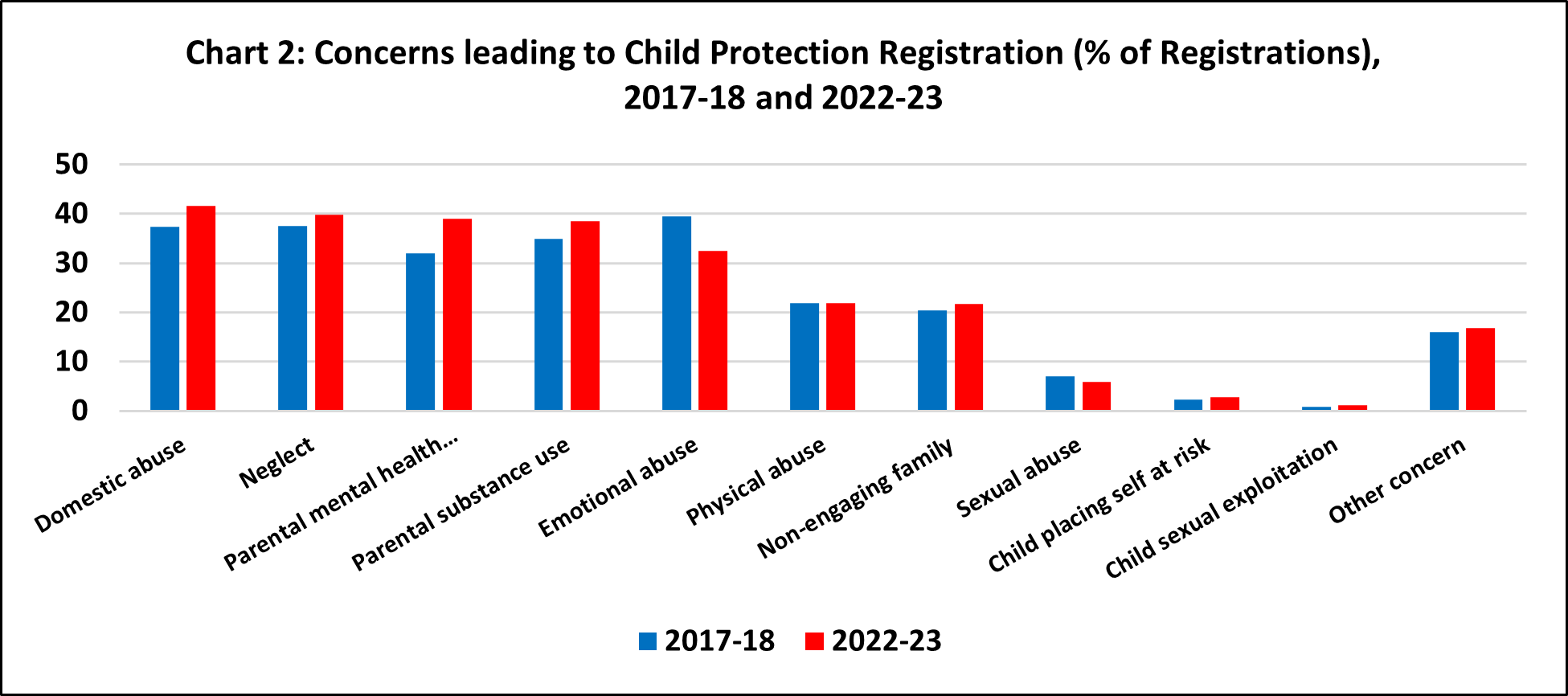What story does Scotland's latest statistics on child protection tell?


The Scottish Government has this week (26 March 2024) published the annual child protection statistics for August 2022 to July 2023. While waiting for this year’s publication, a key question was whether we would see the historically low number of children on the Child Protection Register reported in the previous year’s figures continue, or whether the more recent figures had increased, potentially in response to the strain of the COVID-19 pandemic and the rising cost of living.
The 2022-2023 data shows that there has been a slight increase, from 2,019 children on the Child Protection Register on 31 July 2022 to 2,094 children on 31 July 2023. This suggests that a new trend of around 2,000 children on the Child Protection Register is beginning to be seen, compared to over 2,500 children between 2010 and 2020. Indeed, the most recent Scottish Government’s four-weekly data collection shows that 2,004 children were on the Child Protection Register on 7 February 2024.
So, how do we explain this relatively new decrease? The available cross-UK comparisons within Scotland’s annual child protection statistics show that Scotland’s rate of children on the Child Protection Register is considerably lower than England, Wales and Northern Ireland and, unlike other UK nations, Scotland has been experiencing a consistent decline in the number of children on the Child Protection Register. A number of questions need to be considered then: Does the data demonstrate a positive impact of Getting It Right For Every Child, the National Guidance for Child Protection in Scotland, The Promise, and Scotland’s commitment to the UN Convention on the Rights of the Child? We know change takes time, and that it then takes even longer to evidence that change through statistical data, so does the statistical trend reflect that Scotland’s policy approach is working in terms of preventing risk and harm and providing better support to children and their families?
While it is right to ask whether this is a positive picture we are seeing, we should equally question whether the numbers tell the whole story. There are three aspects that are important to consider here. The first is that the decrease has not been seen across all parts of Scotland. Using the annual child protection statistics data for 2018 and 2023 (chart 1), we can see that the majority of local authority areas have seen a decrease in the number of children on their Child Protection Register, but some have experienced an increase. These differences lead us to ask whether local policy, practice and contextual factors have been more impactful than changes to national policy, practice and services.

The second aspect is that the child protection data largely focuses on harm and abuse within families and may not reflect the changing types of harm and abuse experienced by children in Scotland. From 2018 to 2023 (chart 2), the concerns recorded at registration have changed with domestic abuse, neglect, parental mental health and parental substance use increasing, while emotional abuse has reduced. However, we do not know or see if this reflects the increasing risk of online harm or abuse, or risks from sexual or criminal exploitation, that children are now facing from outside the family setting. With the annual child protection statistics predominantly focusing on child protection registration data, are we missing the insights and intelligence that could be drawn from earlier stages in the child protection process, such as Inter-agency Referral Discussions, Joint Investigative Interviews and Child Protection Medical Examinations?

The third aspect is that important contextual factors – such as child poverty levels, children living in temporary housing, and children with additional support needs – have all been on the rise over the last three years. Children’s and families’ support needs appear to be increasing, and it is known that the stresses and strains of these can increase the risk of children experiencing harm, abuse and neglect. Why then, we might ask, has the number of children on the Child Protection Register fallen over this same time period, particularly when the children’s services workforce is in crisis?
Does it reflect the impact of changes to policy, practice and services, with children’s and families’ support needs being responded to and met earlier? Or perhaps what is happening is that demand for support is increasing, but these children are not at risk of significant harm and abuse and therefore are not placed on the Child Protection Register? Or could there even be some impact from the current workforce recruitment and retention crisis playing out here?
There may be a positive story to tell from the annual child protection statistics but we need more comprehensive data to know if that is the case. Including Inter-agency Referral Discussion, Joint Investigative Interview and Child Protection Medical Examination data in next year’s 2023-2024 publication will be a helpful step forward in understanding what the full picture looks like, but we continue to need to piece together other national and local data and intelligence, as well as addressing the gaps in data not being collected to help us answer these essential questions. Only then can we know what story the statistics are telling us.
Read more about the statistics
The views expressed in this blog post are those of the author/s and may not represent the views or opinions of our funders.
Commenting on the blog posts: sharing comments and perspectives prompted by the posts on this blog are welcome.
CELCIS operates a moderation process so your comment will not go live straight away.


